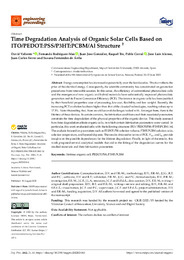Please use this identifier to cite or link to this item:
https://hdl.handle.net/11000/35436Full metadata record
| DC Field | Value | Language |
|---|---|---|
| dc.contributor.author | Corral González, Pablo | - |
| dc.contributor.author | Valiente, David | - |
| dc.contributor.author | Rodríguez-Mas, Fernando | - |
| dc.contributor.author | González, Juan Jose | - |
| dc.contributor.author | Tro, Raquel | - |
| dc.contributor.author | Alonso, Jose Luis | - |
| dc.contributor.author | Ferrer, Juan Carlos | - |
| dc.contributor.author | Fernandez de Avila, Susana | - |
| dc.contributor.other | Departamentos de la UMH::Ingeniería de Comunicaciones | es_ES |
| dc.date.accessioned | 2025-01-28T19:15:26Z | - |
| dc.date.available | 2025-01-28T19:15:26Z | - |
| dc.date.created | 2022 | - |
| dc.identifier.citation | Engineering Proceedings | es_ES |
| dc.identifier.issn | 2673-4591 | - |
| dc.identifier.uri | https://hdl.handle.net/11000/35436 | - |
| dc.description.abstract | Energy consumption has increased exponentially over the last decades. This fact reflects the price of the electrical energy. Consequently, the scientific community has concentrated on generation procedures from renewable sources. In this sense, the efficiency of conventional photovoltaic cells and the emergence of new organic and hybrid materials have substantially improved photovoltaic generation and its Power Conversion Efficiency (PCE). The interest in organic cells has been justified by their beneficial properties: ease of processing, low cost, flexibility, and low weight. Recently, the increasing PCE evolution has been higher than that of the classical technologies, reaching values up to 17.5%. Notwithstanding that, there are still several challenges to deal with. Amongst them, there is the lifetime of these devices. In certain contexts, the fabrication conditions and their associated parameters constrain the time degradation of the physical properties of the organic device. This study assessed how time degradation affects organic cells, in which certain fabrication parameters were varied. In particular, this work evaluated cells with the following structure: ITO/PEDOT:PSS/P3HT:PCBM/Al. The analysis focused on parameters such as PEDOT:PSS solution volume, P3HT:PCBM solution ratio, solution temperature, and layered dopants. The results obtained in terms of PCE, Voc, and Isc provide insights on the possible dependences for the lifetime degradation. Finally, in light of the results, this work proposed several analytical models that aid in the fitting of the degradation curves for the studied materials and their fabrication parameters. | es_ES |
| dc.format | application/pdf | es_ES |
| dc.format.extent | 2 | es_ES |
| dc.language.iso | eng | es_ES |
| dc.publisher | MDPI | es_ES |
| dc.relation.ispartofseries | 21 | es_ES |
| dc.relation.ispartofseries | 1 | es_ES |
| dc.rights | info:eu-repo/semantics/openAccess | es_ES |
| dc.rights | Attribution-NonCommercial-NoDerivatives 4.0 Internacional | * |
| dc.rights.uri | http://creativecommons.org/licenses/by-nc-nd/4.0/ | * |
| dc.subject | lifetime | es_ES |
| dc.subject | organic cell | es_ES |
| dc.subject | PEDOT:PSS | es_ES |
| dc.subject | P3HT:PCBM | es_ES |
| dc.subject.other | CDU::6 - Ciencias aplicadas::62 - Ingeniería. Tecnología | es_ES |
| dc.title | Time Degradation Analysis of Organic Solar Cells Based on ITO/PEDOT:PSS/P3HT:PCBM/Al Structure | es_ES |
| dc.type | info:eu-repo/semantics/article | es_ES |
| dc.relation.publisherversion | https://doi.org/10.3390/engproc2022021041 | es_ES |

View/Open:
engproc-21-00041-2.pdf
459,96 kB
Adobe PDF
Share:
.png)
